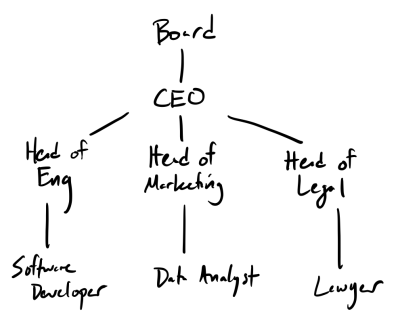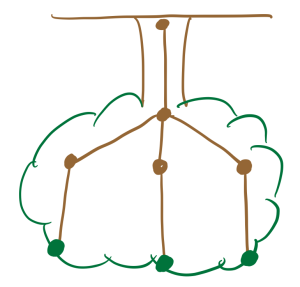Trees
- Summary
- Trees are a class of data structures that organizes data in a hierarchical fashion. We explore trees briefly because they beautifully generalize the recursive definition of lists we have used extensively so far and as a functional language, Scheme is particular adapt at handling this common form of data.
This reading was redeveloped for Fall 2020 and then again for Fall 2021.
Lists as sequential structures
Recall that a list is defined recursively as a finite set of cases:
- The list is empty, or
- The list is non-empty and consists of a head element and the rest of the list, its tail.
In Scheme, you build lists with null (empty list) and
cons (add a value to the front of a list).
You deconstruct lists with null? (check for empty list), car (grab the first element), and cdr (grab everything but the first element).
Every other list operation we use can be built from those basics.
The structure of a list organizes its data in a sequential fashion. That is there is an ordering imposed by the list structure. For example, consider the following list of strings:
(define favorite-fruit (list "pear" "apple" "peach" "grape" "olive"))
The recursive definition of a list implies that we will walk through the elements of the list in left-to-right order. For example, the following recursive function returns the first occurrence of a string that starts with the letter ‘p’:
(define favorite-fruit (list "pear" "apple" "peach" "grape" "olive"))
(define find-first-p
(lambda (l)
(match l
[null (error "(find-first-p) not found!")]
[(cons head tail)
(if (equal? (string-ref head 0) #\p)
head
(find-first-p tail))])))
(find-first-p favorite-fruit)
Note that when used on our sample list, the function returns "pear" rather than "peach" because it encounters "pear" first.
We can use the sequential nature of lists to encode orderings, something that we will revisit at the end of the course when we talk about sorting algorithms. For now, we can observe that if assume that the list contains our favorite fruits in decreasing order of favor, then we can easily define functions that retrieve our most favorite and least favorite fruits from the list:
(define favorite-fruit (list "pear" "apple" "peach" "grape" "olive")) (define most-favorite (lambda (l) (list-ref l 0))) (define least-favorite (lambda (l) (list-ref l (- 1 (length l)))))
In short, we can take advantage of the structure of a data type, here a list, to make defining operations easier as well as more efficient. This is the motivation behind the study of data structures which allow us to organize our data in various ways. Lists are our first example of such a data structure, and perhaps, the most fundamental in all of computing.
Not everything is naturally sequential
Lists work particular well when our data has a natural sequential interpretation or ordering to it. However, not all data behaves in this manner. For example, consider a management hierarchy that describes the groups that the managers of a company oversee:
- There are software developers that all report to the head of engineering.
- There are also testers that all report to the head of engineering.
- There are data analysts that report to the head of marketing.
- There are lawyers that report to the head of legal.
- The different group heads all report to the chief executive officer (CEO).
- The CEO reports directly to the board of directors.
The manner in which employees report to each other seems sequential in nature, but breaks down if we try to put them all into a list. We might try to do so with the board at the head of the list—since they’re the “top” of the management structure—and then work our way downwards.
(define management-hierarchy
(list
"Board"
"CEO"
"Head of Engineering"
"Head of Marketing"
"Head of Legal"
"Software Developer"
"Tester"
"Data Analyst"
"Lawyer"))
The sequential nature of the list implies that the "CEO" reports to the "Board" which is correct.
However, the "Head of Marketing" does not report to the "Head of Engineering"—they are actual equals in the management hierarchy!
Likewise, a "Software Developer" doesn’t manage "Lawyers"; they do not have a direct relationship in terms of management.
Representing hierarchical structures
As the example above suggests, management hierarchies are not sequential in nature.
They are, as suggested by their name, hierarchical.
We can think of a hierarchy as imposing a parent-child structure on data.
In this view, every child has one parent, but parents can have multiple children.
In the above example, an example of a parent would be the "CEO" and its children would be the "Head of Engineering", "Head of Marketing" and "Head of Legal".
Representing hierarchical structures using nested lists
Of course, we could use nested lists to better represent the hierarchy. Each list contains the role (a string) and then any direct reports. If a direct report has its own reports, we represent it as a list. If not, it’s just the string.
(list
"Board"
(list
"CEO"
(list
"Head of Engineering"
"Software Developer"
"Tester"
"Data Analyst")
"Head of Marketing"
(list
"Head of Legal"
"Lawyer")))
If we added a “Lead Tester” role, we might rewrite this as
(list
"Board"
(list
"CEO"
(list
"Head of Engineering"
"Software Developer"
(list
"Lead Tester"
"Tester")
"Data Analyst")
"Head of Marketing"
(list "Head of Legal"
"Lawyer")))
Representing hierarchies with trees
These nested lists appear useful. But perhaps we should formalize what we’re doing. In addition, we know that we have some responsibility to separate what we want to do with the structure from how we implement it. Perhaps nested lists aren’t the way to go.
In computer programs, we represent hierarchies using a data structure called a tree. We might represent the management hierarchy above with a tree pictorially as follows:

In the picture, a line between two names corresponds to a parent-child relationship where the parent is higher in the diagram than its child. We call each element of a tree a node of the tree. We also traditionally use tree terminology to describe the different parts of the structure:
- The
"Board"is the root of the tree. It is the piece of data with no parent. "Software Developer","Tester","Data Analyst", and"Lawyer"are all considered leaves of the tree. Each of them have no children.- Each of the heads have parents and children—we call them interior nodes of the tree. (Ok. That one isn’t really terminology from trees, but you get the point.)
You might note that the "Board" is at the top of tree whereas the roots of the trees are found on the ground.
That is correct!
It turns out that the way computer scientists think of trees are upside-down:

A recursive interpretation of trees
Recall that the key insight behind performing recursive operations over lists was decomposing its structure in a way that we could identify a smaller sub-list inside of a larger list.
We can do the same thing for trees.
In our above example, the overall tree’s root is "Board", but note that this overall tree contains a smaller sub-tree: the sub-tree’s root is "CEO"!
Furthermore, "CEO" contains 3 subtrees with each group head as roots.
With this in mind, we can define a tree recursively as follows. A tree is either:
- Empty, or
- Non-empty where it contains a datum and zero or more children that are, themselves, trees. (We will sometimes use the term “subtrees” rather than “children”.)
Representing binary trees in Scheme
In our example above, the maximum number of children any one of the nodes has is three: the "CEO" has three children.
However, for the purposes of our first exploration into trees, we’ll first look at trees that have at most two children, the so-called binary trees.
When we work with binary trees, we refer to the first child as the “left child” or the “left subtree” and the second child as the “right child” or the right subtree.
How might we represent a tree using the Scheme programming constructs we’ve seen so far?
Note that the only difference between a list and a tree is that a list can only have one sublist whereas a binary tree can have up to two subtrees.
This implies we can use all of our list constructs—null and cons for construction and car and cdr to decomposition.
To represent multiple subtrees, we can use the pair construct we learned about previously: the “tail” of a tree will be a pair of subtrees instead of a single subtree!
However, as we saw in our discussion of data abstraction, encoding a tree in terms of a list has downsides. Writing operations on trees in terms of lists obfuscates our code—it is sometimes not clear that the intricate series of list operations we are performing are actually operating over a tree! Furthermore, it takes a substantial amount of time to write functions to abstract away these low-level details.
Instead, let’s use the struct construct of Scheme to directly define a tree in terms of two types:
- The empty tree is a
leafwith no contained associated values. - The non-empty tree is a
nodecomposed of avalue,leftsubtree, and arightsubtree.
The following pair of struct declarations declares these two types with appropriate fields:
(struct leaf ()) (struct node (value left right))
Note that leaf takes no parameters and thus, it has no fields.
So to create a leaf, we call it as a zero-argument function: (leaf).
Here are some examples of using these structs:
(struct leaf ()) (struct node (value left right)) (leaf) (node "Board" (leaf) (leaf)) (node "Board" (node "CEO" (leaf) (leaf)) (leaf))
The first example is an empty tree, i.e., a tree containing no values.
The second example is a tree containing one node with the value "Board".
The third example is a tree containing two nodes with the values "Board" and "CEO".
Observe that the left-hand child of "Board" is "CEO" and it has no right-hand child, i.e., the right-hand child is a leaf.
As a bigger example, if we restrict our management hierarchy example to just its engineering and legal branches, we can represent this structure in Scheme with our structs as follows:
(struct leaf ())
(struct node (left value right))
(define management-tree
(node "Board"
(leaf)
(node "CEO"
(node "Head of Engineering"
(node "Software Developer"
(leaf)
(leaf))
(node "Tester"
(leaf)
(leaf)))
(node "Head of Legal"
(leaf)
(node "Lawyer"
(leaf)
(leaf))))))
management-tree
While we’ve structured the tree nicely, Scheme is not so clear in printing it out! That’s something that we’ll fix when we write recursive functions over trees a topic for another day!
Self Checks
Check 1: Another example of a tree (‡)
a. Come up with another example of a hierarchical structure that we could represent using trees.
Describe the parent-child relationships in this example.
b. Use leaf and node to give a concrete example of your structure in Scheme.
Make sure your example involves a few levels so that you get practice writing our tree values. (You don’t have to write working code; just practice doing it.)